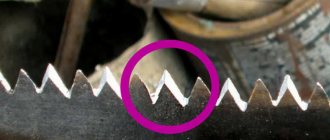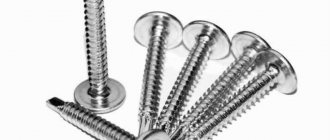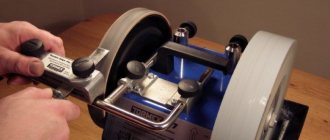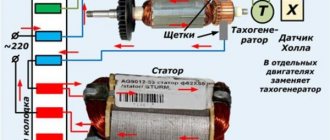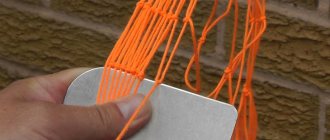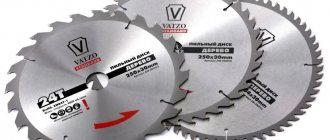A hand saw, despite the variety of electric tools, still remains one of the most popular devices when working with wood.
It is characterized by its low cost, compactness and immediate readiness for use. The use of a hacksaw is especially important when there is no source of electricity.
In order for sawing to be done quickly and correctly, you need to know how to sharpen a hacksaw on wood at home if you don’t have a sharpening machine or a grinder.
How to sharpen a hacksaw yourself
A hacksaw for wood is one of the “eternal” values.
But, in order for a hand saw to always perform its functions, it must be sharpened correctly.
This is where basic knowledge about the type of cutting edge and its features will come in handy.
Of the existing methods, we will consider the safest and most popular ones, using available tools and available for home use.
Video description
The process of sharpening a hacksaw with a grinder is shown in the video:
The operation of restoring a hand saw using an angle grinder is a more painstaking job than sharpening a chainsaw. However, the process is still not too difficult, but only an experienced master can carry it out efficiently.
Using a grinder allows you to reduce sharpening time by almost half compared to using a file. After all, with a hand tool you need to perform synchronous movements and constantly control the amount of material removed from each tooth.
Why sharpen and when?
With constant use, the teeth lose their sharpness, the cutting edges wear out, deteriorating the quality of the cut and increasing the time it takes to complete the task.
Buying a new one will not correct the situation for long, and it will take no more than half an hour to restore the old canvas.
Timely sharpening of the hacksaw will restore the cutting ability of the incisors, and will always allow you to have a working tool at hand.
It is worth correcting the sharpness of the cutting edges at the first signs of wear, which can affect local areas and the entire working surface.
The dimensions of the cutter set also change, and this leads to jamming during operation.
How to sharpen a chainsaw correctly
Timely and competent sharpening of a chainsaw chain with your own hands will not only extend the time of use of the device, but also save effort and time on wood processing. Signs of a sharp chain are the formation of sawdust of the same size and regular geometric shape. To ensure the required level of sharpness of the teeth, any device for sharpening chainsaw chains, for example, any sharpening tool, is suitable. These are a file, a grinder and a machine.
File
Using a set of files is the most common method that can be done at home. But it is not as simple as it might seem at first glance. To carry out sharpening, you will need two types of files: round and flat. Each of them has its own purpose.
Using a round tool, you need to sharpen the working edge of the saw tooth, because its configuration is rounded. For household chainsaws, a file with a diameter of 4-5 mm is used, because the saw teeth are small. Professional saws are sharpened with files with a diameter of 5.2-5.5 mm.
Use a flat file to sharpen the cutting depth limiter. If this edge is not adjusted, the chain will not cut into the wood to the required depth, which will reduce the cutting speed. And this will directly affect both excessive fuel consumption and overheating of the saw engine.
Sharpening with a grinder
Professionals consider this work to be primitive. There is a risk of tire damage, and not only that.
Process (looks easy, but is actually difficult)
- The chain also remains on the bar;
- We attach a cutting disc for metal with a thickness of 1.5-2 mm to the grinder. It is advisable to take something that is not new, that is, with a reworked edge;
- We put a barrier in front of the chain and tire (a sliver will come off);
- We sharpen at the desired angle;
- Upon completion of the work, the chain must be properly tightened.
READ Assembly of the STIHL 180 saw
With a professional approach and a “full hand”, the number of sharpenings in this case can be more than 7.
“For a beginner, it’s better not to “experiment” with a saw, chain, etc. with your body parts!”
Advantages of the method: Fast, cheap and does not take away strength;
Disadvantages: Requires special skills, a steady hand and the ability to follow safety precautions.
Sharpening machines
Nobody in service centers uses files for a long time. Because the right sharpening
chains are precisely maintained parameters of the angle of the teeth and the height of the limiter.
It is difficult to achieve this manually, but the service center guarantees the quality of the operation with long-term operation of the electric or chainsaw.
The variety of sharpening machines is amazing. There are both ordinary simple mechanical devices and electrical ones. At the same time, manufacturers offer small-sized machines that are installed directly on the bar, desktop ones, in which the chain is installed without a bar.
The simplicity of the sharpening procedure is due to the fact that the sharpening machine has a retainer in its design in which the chain is secured. It is installed so that the chain is fixed vertically in it.
You can adjust the installation location of the device. This is quite simple to do, because the latch can move in a horizontal plane. The angle of inclination is determined by the abrasive disk (circle), which is mounted on the motor shaft. This way the sharpener is positioned at the required angle set at the factory. But it can also be changed depending on the required degree of inclination.
For example, for cutting hard wood an angle of 20-25° is required, for soft wood - 30-35°; to cut wood along the grain, you can use chains with a tooth angle of 10°.
The rotation of the disk is carried out by an electric motor, but its immersion is carried out manually by the operator. But even here you can set the necessary parameter so as not to increase the depth of the cut. By the way, the disk is a removable element.
Sharpening the saw. The easiest way
How to determine when it’s time to sharpen a hacksaw?
How to determine when it's time to sharpen the teeth of the tool.
An experienced owner knows when and how to sharpen a hacksaw, but it is not difficult for the average person to determine this point on their own. As a rule, the sound produced during operation and the uniformity of the color of the cutting edge change.
Sharp cutters are characterized by uniform wear of the cutting edge.
The following signs indicate the need to “correct” the saw:
• sawing is difficult and uneven; • the cut is uneven; • the blade often gets stuck; • it becomes difficult to maintain a given trajectory.
In addition, a dull hacksaw often gets stuck and requires a lot of effort to complete the process.
A simple device to help
It is difficult to sharpen a hacksaw efficiently without special tools and a machine, by eye. You have to constantly inspect the teeth to make sure that they are not deformed, but become sharp.
We recommend: Where to celebrate the New Year: top 7 places for those who have saved up some money
If the saw is used frequently, it makes sense to make a device that makes sharpening several times easier and faster.
You will need:
- old boards;
- screws and a screwdriver.
Progress:
- We connect two boards slightly larger than a hacksaw to each other at an angle of 37 degrees. To fasten the parts we use two corners.
- Place the hacksaw on the board so that the cutting edge protrudes.
- We fix it using 3 bosses, self-tapping screws and a screwdriver.
- We fix the device itself on the table using 2 clamps.
How to sharpen a hacksaw with your own hands
How to sharpen a hacksaw yourself if the need arises?
First you need to decide what material the work cloth is made of.
Ordinary steel can be corrected independently, but teeth with pobeditovy tips can only be processed on specialized industrial machines.
Some craftsmen, at their own peril and risk, undertake to sharpen a hacksaw using a grinder - but this is an unreliable and dangerous method.
To tidy up an ordinary manual hacksaw for wood at home, you will need to determine the shape of the teeth, prepare everything you need, and be sure to follow safety precautions.
An easy way to sharpen a circular saw blade
Hello, dear readers and DIYers! In this article, the author of the YouTube channel “GRINwood” will tell you how you can sharpen a saw blade for wood with carbide tips (for a circular saw) yourself.
The most interesting thing is that the capabilities of the circular saw itself will be used to sharpen the disc. Materials. — Maple lumber — Sheet plywood — Countersunk screw, washers — Wing nuts.
Tools used by the author. — Diamond grinding discs 150 mm, 150/180/240/320 grit — Circular saw, wood saw blade — Screwdriver — Countersink drill — Clamps — Marker, ruler, pencil, wrenches. Manufacturing process. Over time, the saw blade becomes dull and begins to leave marks on the workpiece. The author clearly demonstrates this by temporarily stopping the workpiece for a split second while making a cut.
On the front side of the jig he marked a line coaxial with which the sharpening disc should be located. The hole to which the saw blade will be attached is shifted to the side. This will give you the required angle of 15 degrees.
The disc is secured to the jig using a bushing, washer and wing nut.
The master sets the stop so that the plane of the sharpening disk and the tooth coincide.
Now you can turn on the engine. The edge of the sharpening disk is brought to the solder, and the saw blade is smoothly turned counterclockwise. This is how all the “left” teeth are sharpened.
The master repeats the processing of the workpiece exactly, stopping it periodically. Even with a delay of a second or more, no marks were formed, and the surface of the workpiece was almost perfect.
Good mood, good luck, and interesting ideas to everyone!
The author's video can be found here. Source
General requirements for sharpening
Not every garage or workshop has a special machine for sharpening hacksaws, but it won’t hurt to sharpen the tool yourself.
There are, of course, exceptions - hardened teeth cannot be sharpened.
Diamond drills and other tricks will not help.
This saw has an increased service life and must not be repaired, but replaced with a new one.
It is easy to identify hardened steel - it is distinguished by its black color with a blue tint.
A grinder or a file and a needle file are usually used as a sharpener for a hacksaw.
A prerequisite is to first carry out the correct setting of the teeth, because the thickness of the hacksaw blade affects the width of the cut, so the edges must be bent to the required width.
The nuances of sharpening a hand saw
When sharpening a hand saw for wood, each master follows a number of rules:
- The hacksaw is most securely attached to a workbench or other fixed base when using a vice or clamps. This will allow you to sharpen the saw efficiently and reduce the likelihood of injury.
- The work area is well illuminated so that even very small teeth can be clearly seen.
- Movements with a sharpening tool are performed exclusively in one direction if the process is carried out with a file.
In addition, to quickly check the quality of sharpening, use sunlight. When hit by rays, the teeth begin to shine if the sharpening process is carried out correctly.
Necessary tool
Sharpening a hacksaw using a grinder or grinder requires certain skills.
It is much safer and easier to sharpen a hacksaw mechanically.
Before you begin, prepare a vice or clamp, calipers, hammer and other necessary tools:
Crosscut saws are sharpened at an angle of 60 degrees using a triangular fine file.
Longitudinal with an angle of less than 60 degrees - use a large needle file or diamond file with fine abrasive.
For a mixed type, you will need a coarsely cut file or a finely cut diamond file.
For this operation, a special sharpening device is useful - a wooden block with a cut-out socket to protect your hands from cuts.
NOTE:
To sharpen a hacksaw using a grinder, you will need a cutting wheel with a thickness of 1.2 to 1.4 mm, with a diameter of 115 or 125 mm. The angle grinder must have a speed adjustment in the range of 5000 - 8000 per minute. Installing protection is a prerequisite for using this method. As a rule, a homemade shield made of transparent plastic is used.
Wood saw sharpening technology
Proper sharpening of a hacksaw should preserve the working profile of the teeth.
It is determined by the following parameters:
• pitch and height; • point angle; • radius of curvature.
The sharpening angle can be set in the range from 30 to 60 degrees, and depends on the material.
So, for soft wood, 50 degrees will be optimal.
It is important to secure the blade correctly in the vice - do not clamp it too hard, as the steel will vibrate under the file.
Using a workbench and a clamp, you can conveniently secure the hacksaw.
Sharpening is done by alternating double-sided sharpening - first, one row is passed along the left edges of all teeth.
Then the tool is turned over and the passage along the right half of the cutters is repeated.
The one-way method is not used for straightening hand saws - it is applicable only to certain types of knives.
Features of sharpening using an angle grinder
Experts also use a grinder to sharpen hacksaws. The use of power tools simplifies the process. It is used for sharpening hand saws and chainsaws. An experienced master performs the process as follows:
Before sharpening the saw, the specialist selects a blade for the grinder.
For this process, a thin circle is used. Therefore, conventional sharpening discs are not suitable. The master selects a circle based on the distance between the saw teeth. Usually its thickness does not exceed 1.5 mm. The disk with this parameter is 0.8 mm is most often used.
The master clamps the hacksaw using clamps.
Vices are used extremely rarely, because in them the blade can only be positioned vertically. This position is ideal when the process is carried out with a file. It is inconvenient to sharpen a vertically positioned blade with a grinder.
The hacksaw blade is usually clamped with clamps in a horizontal plane when sharpening with a grinder is performed. Source i3.guns.ru
Wooden pads are used together with the vice. They usually look like bars. Wooden linings allow you to more securely fix the hacksaw. To secure the saw, two clamps are used to prevent any movement and vibration of the blade being sharpened.
The specialist sharpens each saw tooth.
The power tool performs movements between these elements along their edges, having previously selected the desired angle of position of the angle grinder disk.
The master sharpens the teeth first on one side of the saw, and then repeats the procedure on the other side of the hacksaw.
How to properly sharpen a hacksaw with a file
Using a file is still relevant today, so let’s try to figure out how to properly sharpen a hacksaw at home.
Let's start by installing the canvas.
It must be secured, as already mentioned above, in a clamp or vice.
The jaws of the vice must be made of wood, with the width of the “jaws” not less than 200 mm.
The movement of the file should be uniform, and pressure on the teeth should only be applied when moving “forward”.
It is necessary to move the hand with the tool to the starting point freely, without force on the incisors.
In one working pass, a uniform layer of metal is removed, this will preserve the pitch, height and profile of the edge.
The sharpness of the cutter can be reduced due to the formation of burrs on the surface and irregularities after passing the abrasive.
A file cannot sharpen a hacksaw perfectly, but you can get high quality - after sharpening, the smallest file or needle file and whetstone will come in handy.
Burrs are removed by selective grinding with a fine abrasive, and the edges are leveled with a wet whetstone along the side base of the blade.
When you set out to sharpen a hacksaw correctly, pay attention to maintaining the tops of the teeth.
The same height of the cutters and correct setting affect the wear resistance of the tool and the quality of the cut.
How to check if your saw is sharpened correctly
After finishing the process of sharpening a tool for working with wood, it is worth checking each tooth of the hacksaw against the light. If shine is visible, the sharpening was done correctly; if not, then you should go over the “suspicious” teeth again. You should also check whether the teeth on the blade are the same height. If they are higher or lower, this will lead to lower cutting quality and blade wear will be unevenly distributed.
Is the saw sharpened correctly?
As a result, when sharpening a hacksaw blade, you need to adhere to the following recommendations:
- The blade must be securely secured in a vice without the slightest sign of slipping during the process.
- The workplace should be as illuminated as possible; this will not only allow you to work normally with the tool, but will also protect your eyes from wearing glasses prematurely.
- The depth of the cut of the selected file depends only on the degree of dullness of the teeth - the duller, the more “powerful” the tool is needed.
- Sharpening of metal occurs only when moving away from you and only in one direction. This prevents hand injuries from accidentally touching the canvas during movement.
- After finishing sharpening, it is necessary to check the quality of the work performed, and in case of unevenness, it is better to correct it immediately than to suffer later in the process of sawing wood, especially hardwood.
On a note. When using a hacksaw, you should regularly pay attention to its performance. This will save effort, nerves and the tool will last a very long time if handled with care.
Any tool should be checked before and after completion of work. Safety first! If with a hand tool there will only be a cut at best, then with an electric one it can result in a lifelong injury. Therefore, it is recommended to inspect the instruments before use.
All the recommendations and warnings will help you properly sharpen any hand saw for working with wood, and you won’t have any problems determining when to do it.
voice
Article rating
Hacksaw teeth set
The movement of the blade must be free, for which the saw teeth are set apart by the same amount.
To reduce the coefficient of friction and the clamping of the hacksaw in the cut, its width must be greater than the thickness of the working blade, otherwise the metal heats up and expands, which leads to the saw jamming.
The teeth of the hacksaw are set by bending the cutters to the sides.
Using pliers does not allow you to obtain the same angle of inclination - with such a tool you can only cut firewood.
To spread the cutters evenly and get an even, neat cut, use a homemade device for setting the teeth.
To make it, you need a metal die of arbitrary shape with a thickness of 2-3 mm.
In a simple version, several slits are made to indicate the thickness of the canvas.
The tooth is grabbed into the hole and bent until the selected stop is reached.
In the second version, a cut is cut into the plank with a metal file, and two holes are drilled to install the limiter.
Rotating the sector to the sides allows you to adjust the bend angle.
The figure shows a simple model and wiring with a stop.
The design of the device is intuitively easy to manufacture and use.
It is necessary to take into account that the width of the bend has its own parameters.
Saw layout
Tooth setting pliers
Tooth setting pliers are a good tool. Its cost can be compared with the price of a hand saw: 300-500 rubles. It is very convenient to use; the saw tooth moves to the side as needed.
Wiring for a hacksaw. It’s also a good thing and inexpensive—the average price is around 100 rubles. The design is simple: several slots and an adjustable angle gauge. The tooth is inserted into a slot of suitable size, and the setting is carried out by applying pressure to the handle. The set protractor ensures uniform distribution.
Wiring for hacksaw
You don’t have either one at home, but don’t want to run to the store? Then you can use the old-fashioned method - it has been used since the beginning of time. All you need is an ax and some dexterity so as not to damage your hands (for people who are not good with tools, do not use this method - it is dangerous!).
The technology is simple : the blade is inserted between two teeth and by turning the ax, the teeth bend to the sides.
Setting teeth with an ax
The saw can also be routed using a self-tapping screw. It's more secure. For this you need a long screw - to make it more convenient to hold. It needs a little modification before work. You need to grind off its cap a little on one side to make it flat. This is necessary so that when it is applied to the tooth, it does not slip off and deform the latter.
The hacksaw should lie flat on soft wood (pine, spruce). Holding the self-tapping screw by the leg, apply the head to the tooth and hit it with a hammer. The tooth bends. The operation is performed through the tooth. Afterwards, the saw blade is turned over and the operation is repeated in the same way.
Setting teeth using a self-tapping screw
Requirements for the setting of hacksaw teeth
When bending the cutters one at a time on both sides of the canvas, maintain a certain value that can be set on a homemade device.
The width of the wiring depends on the type of wood.
Soft and damp wood requires a larger angle of inclination than dry wood.
As a rule, hand tools work effectively with an average value of 0.2-0.3 mm.
At the same time, the total value should not exceed the width of the canvas.
In addition, the same nature of the bend on each side is observed.
The wiring for the hacksaw is checked visually or using a caliper.
Pay attention to the size of the tooth - the height of the incisor is especially important.
How to tell if a chain is dull
The long service life of any chainsaw depends on proper care and use, including the chain set. The good performance of the latter affects the performance of the device and performance parameters. Untimely sharpening can cause some problems in the operation of the saw itself. Most often this is:
- crooked cuts;
- heavy loads on the saw, resulting in increased wear of device parts, and hence a decrease in the service life of the entire device;
- increased fuel consumption.
There are other signs of a dull chain:
- the speed of the tool has decreased;
- uneven and sharp sawdust is formed;
- it is necessary to make great efforts to cut wood;
- the chain has stretched or begun to sag.
Leveling the height of the links
All teeth must be the same height.
An uneven edge results in uneven loading and significantly reduces work efficiency.
Checking the height of the hacksaw teeth
It is necessary to check the height of the teeth before sharpening the tool.
To do this, place a sheet of plain paper on a hard and flat surface, and press the cutters tightly until a clear imprint is obtained.
If there are teeth protruding from the general row, traces of them will be reflected on the print.
If there are higher teeth, they are carefully cut down with a flat file to the general level.
Briefly about the main thing
To sharpen a saw intended for sawing wood, it is first clamped in a vice. Then the teeth are set. Then they are leveled in height. Next, take a triangular file and sharpen the prepared teeth with it, first on one and then on the other side of the hacksaw.
When using a grinder, the saw is secured with clamps on a stationary surface. The plane of its canvas should be horizontal relative to the ground. In this case, a disk with a minimum thickness is installed on the grinder. They sharpen saw teeth at an angle of 15-30°.
To cut wood, a classic saw is often used. There are also reward, round, plywood, trigger, two-handled, and axed hacksaws for wood. Each of them consists of a canvas and at least one handle.
Types of discs and teeth, as well as features of their restoration
The teeth of the disk are made of a specialized alloy of tungsten and cobalt (this is evidenced by the markings on the “front” side of the disk - VK, VK6, etc.).
Important! The durability of a disc depends not only on the alloy, but also on the amount and correctness of the work performed.
The tooth has the following geometric planes:
- Front;
- Rear;
- Side – two auxiliary faces.
When geometric planes intersect, two working (cutting) edges arise:
- Home.
- Auxiliary.
Geometric tooth shape:
- Direct . With their help, wooden sheet material is sawn in the longitudinal direction.
- Trapezoidal . This shape ensures long sharpening when working with wood of different hardnesses.
- Beveled . The main or auxiliary edge has an angular bevel, which allows the disk to cut not only into a homogeneous wood structure, but also into laminated chipboards and fiberboards. In addition, the “beveled tooth” can cut plastic.
- Conical . A universal shape that allows for longitudinal and transverse cutting. This form has one drawback, which is the rapid loss of the sharpness of the working edge.
